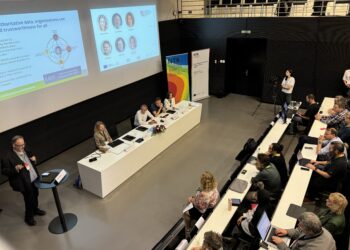- World income map, Wikipedia
Free access to the scientific literature has the greatest effect on the poor — but not poorest — countries, a new study finds.
A short article, “Open Access and Global Participation in Science,” was published in today’s issue of the journal Science. It was authored by sociologist James Evans and graduate student Jacob Reimer, both from the University of Chicago. The journal also hosts a podcast interview.
You’ll recall that Evans was responsible for another controversial article published last summer claiming that online access to the scientific literature results in a narrowing of citations.
Today’s article measured the effect of commercial and free access to the scientific literature on article citations. It focuses on differences across rich and poor countries based on their per capita gross national income.
Evans and Reimer report that the influence of free access on citations was much smaller than other have proposed, about 8% for recently published research. It was more than twice as large, however, for the developing world, although the effect diminished for the poorest countries. They write:
our work provides clear support for its ability to widen the global circle of those who can participate in science and benefit from it
Advocates for open access will see this article as supporting their cause. But those who spend time reading the methodology will notice that message is not as clear as the article implies.
The researchers are not comparing open access journals with subscription-access journals, as reported in the recent article by Tove Faber Frandsen. Evans and Reimer are comparing the effect of freely available articles to subscription-access articles. But this is still an oversimplification.
Due to the size of the study (26 million articles published between 1998 and 2005 in over 8,000 journals), the researchers were unable to code individual articles as being OA or not, so they coded entire volumes. For example, articles from the journal Science are OA when they are older than one year. Articles from PNAS are all subscription-access in the first six months (in spite of the fact that about one-third are author-pays OA), after which they are all coded OA. Because of the macro-level of the study, no attempt was made to find other sources of free copies. In other words, this study focuses entirely on open access publishing. Some freely available articles will be coded as subscription-access articles, and the result is an overly conservative estimate of the open access effect.
The important detail that may be missed is that the source of the vast majority of OA articles in this study were published by non-profit scientific societies who use the subscription model in tandem with a delayed-access model. If anyone should be claiming victory, it should be them.
(In next week’s post, I’ll explore the debate over Open Access from a framing standpoint and why non-profit scientific publishers have been grouped with commercial publishers as villains and impediments to the dissemination of science. )

Discussion
7 Thoughts on "Open Access and Global Participation in Science"
Phil,
Thank you for the summary. It seems like the results are further complicated by the number of non-profit scientific societies who grant free access to all articles to users coming from countries defined as “developing economies”. There are a number of these programs and they grant even wider access than the traditional delayed-access model for those users outside of traditional economic powers. Was that complication adequately accounted for in the study?
Thanks Todd. Based of my reading of the methodology, it doesn’t appear that programs that promote the free access of scientific literature to developing countries (such as HighWire’s program , AGORA or HINARI) are factored into the model.
Evans reports that the open access effect is much lower for these countries and chalks it up to limited Internet access, although it might equally be the effect of these programs.
Evans & Reimer (2009) (E & R) show that a large portion of the increased citations generated by making articles freely accessible online (“Open Access,” OA) come from Developing-World authors citing OA articles more. It is very likely that a within-US comparison based on the same data would show much the same effect: making articles OA should increase citations from authors at the Have-Not universities (with the smaller journal subscription budgets) more than from Harvard authors. Articles by Developing World (and US Have-Not) authors should also be cited more if they are made OA, but the main beneficiaries of OA will be the best articles, wherever they are published. This raises the question of how many citations – and how much corresponding research uptake, usage, progress and impact – are lost when articles are embargoed for 6-12 months by their publishers against being made OA by their authors. (It is important to note that E & R’s results are not based on immediate OA but on free access after an embargo of up to a year or more.)
One also cannot miss the irony that the article itself isn’t open access…so regardless of the time window, the ability to evaluate the work is available only to those that subscribe.
Nicely put Gabriel, the same thing struck me when I saw this. Although this probably shouldn’t be surprising given the multitude of opportunities available for education in the western world, being able to take access more directly into account seems virtually impossible to me given the huge amount of variables involved.

![Reblog this post [with Zemanta]](http://img.zemanta.com/reblog_e.png?x-id=30cfd853-26bd-4575-9ce5-9def23a4696d)


